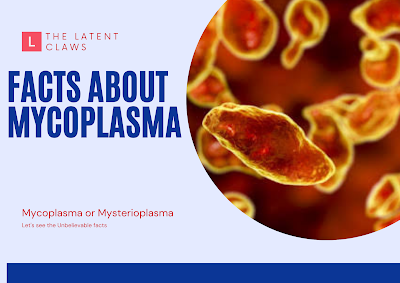Mycoplasma or Mysterioplasma? History About Mycoplasma
Hello and welcome to The Latent Claws, I am Mohd Dayan and showing the unbelievable facts about Mycoplasma, did you ever heard about Mycoplasma, but I bet that this facts you didn't hear before.
What is Mycoplasma?
Mycoplasma (plural mycoplasmas or mycoplasmata) is a genus of bacteria that lack a cell wall around their cell membranes.This characteristic makes them naturally resistant to antibiotics that target cell wall synthesis (like the beta-lactam antibiotics). They can be parasitic or saprotrophic. Several species are pathogenic in humans, including M. pneumoniae, which is an important cause of "walking" pneumonia and other respiratory disorders, and M. genitalium, which is believed to be involved in pelvic inflammatory diseases. Mycoplasma species are the smallest bacterial cells yet discovered,can survive without oxygen, and come in various shapes. For example, M. genitalium is flask-shaped (about 300 x 600 nm), while M. pneumoniae is more elongated (about 100 x 1000 nm). Hundreds of mycoplasma species infect animals.
| Domain | Bacteria |
|---|---|
| Phylum | Tenericutes |
| Class | Mollicutes |
| Order | Mycoplasmatales |
| Family | Mycoplasmataceae |
| Genus | Mycoplasma |
| Kingdom | Monera |
The term mycoplasma, from the Greek μύκης, mykes (fungus) and πλάσμα, plasma (formed), was first used by Albert Bernhard Frank in 1889 to describe an altered state of plant cell cytoplasm resulting from infiltration by fungus-like microorganisms.Julian Nowak later proposed the genus name Mycoplasma for certain filamentous microorganisms imagined to have both cellular and acellular stages in their lifecycles, which could explain how they were visible with a microscope, but passed through filters impermeable to other bacteria.
Later, the name for Mycoplasma was pleuropneumonia-like organisms (PPLO), broadly referring to organisms similar in colonial morphology and filterability to the causative agent (a mycoplasma) of contagious bovine pleuropneumonia.
Characteristics
Over 100 species have been included in the genus Mycoplasma. Microbes of the class Mollicutes, to which Mycoplasma belongs, are parasites or commensals of humans, animals, and plants. The genus Mycoplasma uses vertebrate and arthropod hosts. Dietary nitrogen availability has been shown to alter codon bias and genome evolution in Mycoplasma and Phytoplasma.
Mycoplasmal bacteria are also known as mollicutes. They are the simplest and the smallest free-living prokaryotes.
Mycoplasmal bacteria have been found in the pleural cavities of cattle suffering from pleuropneumonia. These organisms are often called MLO (mycoplasma-like organisms) or PPLO (pleuropneumonia-like organisms).[citation needed]
Important Characteristics
- Cell wall is absent and plasma membrane forms the outer boundary of the cell.
- Due to the absence of cell walls these organisms can change their shape and are pleomorphic.
- Lack of nucleus and other membrane-bound organelles.
- Genetic material is a single DNA duplex and is naked.
- Ribosomes are 70S type.
- Possess a replicating disc at one end which assists replication process and also the separation of the genetic materials.
- Heterotrophic nutrition. Some live as saprophytes but the majority are parasites of plants and animals. The parasitic nature is due to the inability of mycoplasmal bacteria to synthesise the required growth factor.



No comments
Give your thoughts